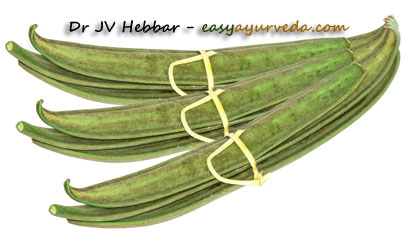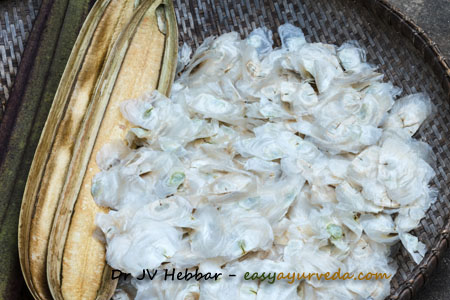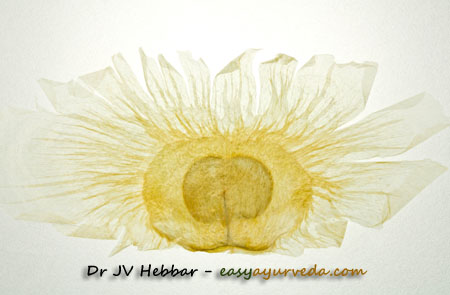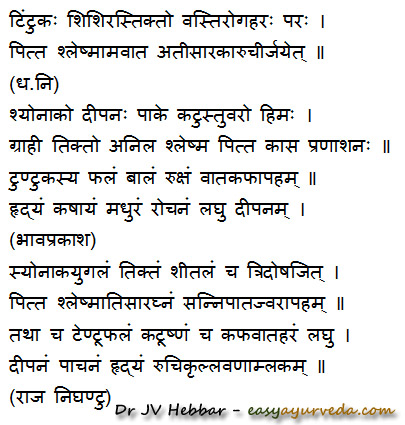Sona Patha Oroxylum indicum Benefits, Side Effects, Research
Sona Patha or Shyonaka (Oroxylum indicum) is an effective Ayurveda medicinal herb. It is one among Dashamoola, used in fever, cough, diarrhea etc. It is a potential herb against cancer, due to its potential cytotoxic and anti metastatic properties.

Botanical name- Oroxylum indicum (Linn) Vent.
Family- BIGNONACEAE – Shyonaka Kula
Table of Contents
Vernacular names
English name – Broken Bones Tree, Indian trumpet flower, midnight horror, oroxylum, kampong
Hindi Name – Sonapatha – Sona means gold. Its inner layer of bark is golden yellow in color.
Telugu Name – Dundilam/ Pampini
Bengali Name – Sona, Shona
Marati & Gujarati Name- Tentu
Tamil name – Addi
Assamese name: Bhatghila
Kannada Name- Tiguda, Tigadu mara, tattuna, Tigda
Malayalam Name – Palagapaimani
Chinese : hanyu pinyin : mù húdié, butterfly tree
Oriya name: Archangkawm, Phanphania, Tatelo
Sanskrit synonyms
Tuntuka – the flowers are bell shaped,
Prithu shimba – fruits are flat and long
Ari Simbi, Katvanga, Kutannata, Dirghavrnk, Mandukaparna, Sukanasa, Bhalluka, Mayurajangha

Classical categorization
Charaka-
Shothara – anti inflammatory group of herbs,
Sheeta Prashamana – cold cough subsiding group of herbs
Anuvasanopaga – group of herbs that are used in Oil enema (Anuvasana basti).
Susruta- Rodharadi, Viratavadi, Brhat pancamula
Vagbhata – Rodhradi, Viratarvadi
Raja Nighantu mentions Shyonaka Yugala (twin) – indicating Oroxylum indicum and Aralu (Ailanthus excelsa)
Distribution
Found in the warmer parts of India (up to 1000 m of height) also cultivated as an avenue tree.

Chemical constituents
Oroxylum indicum chemical constituents
Baicalein, Tetuin, Oroxindin, aloe-emodin, Chrysin, 6 methylether of baicalein= oroxylium A; p-coumaric acid, scutellarein-7- rutinoside, prunetin, B-sitosterol etc.
(Reference: Illustrated Dravyaguna Vijnana, Vol. II, by Dr JLN Shastry)
Medicinal qualities
Sona Patha Medicinal Qualities:
Rasa (taste) – Madhura (sweet) Tikta – Bitter, Kashaya – Astringent
Guna (qualities)- Laghu (light to digest), Rooksha (dry)
Vipaka – taste conversion after digestion-Katu (pungent)
Veerya – Ushna – hot potency
Effect on Tridosha – Kapha-Vatahara
Part used, dosage
Part used- root bark, fruit
Its leaves and stem are edible.
Dosage- Powder 3-6 g, water decoction – decoction 40-80 ml, Ghana satva (water extract) – upto one gram, in divided dose, per day.
Side effects
No known side effects. Safe to use in lactation period and in children. To be used only under medical supervision during pregnancy.
Sanskrit verse

Uses
Shyonaka – Oroxylum indicum – uses
Root –
Vastiroga hara para – one of the best herbs to treat urinary tract disorders
Amavata – useful in rheumatoid Arthritis
Atisara – useful in diarrhea
Aruchihara – useful in anorexia
Deepana – improves digestion strength
Grahi – has absorption qualities, useful in IBS
Kasa – useful in cold, cough
Sannipata Jwara – useful in fever due to Vata, Pitta and Kapha Dosha imbalance
Sona patha fruit –
Unripe fruit is rooksha (Dry), balances Vata and Kapha
Hrudya – good for heart
Rochana – improves taste
Laghu – light to digest
Deepana – improves digestion strength
It is good for skin, useful to cleanse wounds
It cleanses and detoxifies blood, used in gynecological disorders
It is useful in childhood psychological disorders
Interaction with medicines, supplements
Can this be used while taking Homeopathic medicine?
Yes. This product does not react with homeopathic medicine.
Can
this medicine be continued while taking supplements like multivitamin tablets,
Omega 3 fatty acids etc?
Yes. Generally, this product goes well with most
of the dietary supplements. However, if you are taking more than one product
per day, please consult your doctor for an opinion.
With western
medicines
Seek your
doctor’s advice if you are taking this product along with other western
(allopathic / modern) medicines. Some Ayurvedic herbs can interact with modern
medicine.
If both Ayurvedic and allopathic medicines are advised together, then it is
best to take Allopathic medicine first, wait for 30 minutes and then take the
Ayurvedic medicine.
Research
Antimicrobial activity of stem bark
Anti Arthritis activity
Immuno-modulatory activity
Effect on human breast cancer cell
Oroxin A from Oroxylum indicum prevents the progression from prediabetes (research)
Oroxin A was purified from OISE and its PPAR? transcriptional activation was determined in vitro and in vivo. The prediabetic mice were established by high-fat diet and streptozotocin, which was followed by treatment with oroxin A. The effect of oroxin A was determined by analysis of the lipid profiles, oxidative stress, hepaticfunction and histology. The mechanism of oroxin A was also investigated.
Ayurveda medicines
Ayurveda medicines with Oroxylum indicum ingredient –
Because it is one among Dashamoola – group of 10 roots, with potent anti inflammatory activity, it is an ingredient of all medicines containing Dashamoola – like
Dasamoolarishtam – used in after delivery mother care, cold, fever, cough etc.
Dhanwantaram tailam – used in rheumatoid arthritis, osteo arthritis, for external and internal use.
Dhanwantararishtam – another medicine used in post natal care of mother
Sthanika Karma (Systemic Action)
External Application: Antipyretic, Analgesic and wound healing. Bark juice can be applied on wounds. In joint pain and inflammation its decoction can be used externally.
Internal administration-
Nervous system – Indicated in pain due to vitiated vata dosha.
Digestive System – Carminative, digestive, absorbent,
Sona Patha or Shyonaka (Oroxylum indicum) is an effective Ayurveda medicinal herb. It is one among Dashamoola, used in fever, cough, diarrhea etc. It is a potential herb against cancer, due to its potential cytotoxic and anti metastatis properties.

Botanical name- Oroxylum indicum (Linn) Vent.
Family- BIGNONACEAE – Shyonaka Kula
Vernacular names
English name – Broken Bones Tree, Indian trumpet flower, midnight horror, oroxylum, kampong
Hindi Name – Sonapatha – Sona means gold. Its inner layer of bark is golden yellow in colour.
Telugu Name – Dundilam/ Pampini
Bengali Name – Sona, Shona
Marati & Gujarati Name- Tentu
Tamil name – Addi
Assamese name: Bhatghila
Kannada Name- Tiguda, Tigadu mara, tattuna, Tigda
Malayalam Name – Palagapaimani
Chinese : hanyu pinyin : mù húdié, butterfly tree
Oriya name: Archangkawm, Phanphania, Tatelo
Sanskrit synonyms
Tuntuka – the flowers are bell shaped,
Prithu shimba – fruits are flat and long
Ari Simbi, Katvanga, Kutannata, Dirghavrnk, Mandukaparna, Sukanasa, Bhalluka, Mayurajangha

Classical categorization
Charaka-
Shothara – anti inflammatory group of herbs,
Sheeta Prashamana – cold cough subsiding group of herbs
Anuvasanopaga – A group of herbs that are used in Oil enema (Anuvasana basti).
Susruta- Rodharadi, Viratavadi, Brhat pancamula
Vagbhata – Rodhradi, Viratarvadi
Raja Nighantu mentions Shyonaka Yugala (twin) – indicating Oroxylum indicum and Aralu (Ailanthus excelsa)
Distribution
Found in the warmer parts of India (up to 1000 m of height) also cultivated as an avenue tree.

Chemical constituents
Oroxylum indicum chemical constituents
Baicalein, Tetuin, Oroxindin, aloe-emodin, Chrysin, 6 methylether of baicalein= oroxylium A; p-coumaric acid, scutellarein-7- rutinoside, prunetin, B-sitosterol etc.
(Reference: Illustrated Dravyaguna Vijnana, Vol. II, by Dr JLN Shastry)
Medicinal qualities
Sona Patha Medicinal Qualities:
Rasa (taste) – Madhura (sweet) Tikta – Bitter, Kashaya – Astringent
Guna (qualities)- Laghu (light to digest), Rooksha (dry)
Vipaka – taste conversion after digestion-Katu (pungent)
Veerya – Ushna – hot potency
Effect on Tridosha – Kapha-Vatahara
Part used, dosage
Part used- root bark, fruit
Its leaves and stem are edible.
Dosage- Powder 3-6 g, water decoction – decoction 40-80 ml, Ghana satva (water extract) – upto one gram, in divided dose, per day.
Side effects
No known side effects. Safe to use in lactation period and in children. To be used only under medical supervision during pregnancy.
Sanskrit verse

Uses
Shyonaka – Oroxylum indicum – uses
Root –
Vastiroga hara para – one of the best herbs to treat urinary tract disorders
Amavata – useful in rheumatoid Arthritis
Atisara – useful in diarrhea
Aruchihara – useful in anorexia
Deepana – improves digestion strength
Grahi – has absorption qualities, useful in IBS
Kasa – useful in cold, cough
Sannipata Jwara – useful in fever due to Vata, Pitta and Kapha Dosha imbalance
Sona patha fruit –
Unripe fruit is rooksha (Dry), balances Vata and Kapha
Hrudya – good for heart
Rochana – improves taste
Laghu – light to digest
Deepana – improves digestion strength
It is good for skin, useful to cleanse wounds
It cleanses and detoxifies blood, used in gynecological disorders
It is useful in childhood psychological disorders
Interaction with medicines, supplements
Can this be used while taking Homeopathic medicine?
Yes. This product does not react with homeopathic medicine.
Can this medicine be continued while taking supplements like multivitamin tablets, Omega 3 fatty acids etc?
Yes. Generally, this product goes well with most dietary supplements. However, if you are taking more than one product per day, please consult your doctor for an opinion.
With western
medicines
Seek your
doctor’s advice if you are taking this product along with other western
(allopathic / modern) medicines. Some Ayurvedic herbs can interact with modern
medicine.
If both Ayurvedic and allopathic medicines are advised together, then it is
best to take Allopathic medicine first, wait for 30 minutes and then take the
Ayurvedic medicine.
Research
Antimicrobial activity of stem bark
Anti Arthritis activity
Immuno-modulatory activity
Effect on human breast cancer cell
Oroxin A from Oroxylum indicum prevents the progression from prediabetes (research)
Oroxin A was purified from OISE and its PPAR? transcriptional activation was determined in vitro and in vivo. The prediabetic mice were established by a high-fat diet and streptozotocin which was followed by treatment with oroxin A. The effect of oroxin A was determined by analysis of the lipid profiles, oxidative stress, , hepatic function and histology. The mechanism of oroxin A was also investigated.
Ayurveda medicines
Ayurveda medicines with Oroxylum indicum ingredient –
Because it is one among Dashamoola – group of 10 roots, with potent anti inflammatory activity, it is an ingredient of all medicines containing Dashamoola – like
Dasamoolarishtam – used in after delivery mother care, cold, fever, cough etc.
Dhanwantaram tailam – used in rheumatoid arthritis, osteoarthritis, for external and internal use.
Dhanwantararishtam – another medicine used in post natal care of mother
Sthanika Karma (Systemic Action)
External Application: Antipyretic, Analgesic and wound healing. Bark juice can be applied on wounds. In joint pain and inflammation its decoction can be used externally.
Internal administration-
Nervous system – Indicated in pain due to vitiated vata dosha.
Digestive System – Carminative, digestive, absorbent, Anthelmintic, Anti microbial. indicated in loss of appetite, diarrhea, etc.
Circulatory System – Indicated in edema.
Excretory System – Mutrajanana (Increases urine production), indicated in Urinary tract inflammation
Respiratory System – Pacifies kapha dosha, Indicated in Cough, and other respiratory disorders.
Skin – Stimulate sweat production, On the skin it can be used along with caster oil.
Tapakrama – Indicated in fever (Sannipatajvara)
Satmikarana – promote body strength and immunity











6 comments
Ansh
Sir dosen’t it helps to relieve constipation?
Dr J V Hebbar MD(Ayu)Author
No. Please note that it is different than Sonamukhi seeds, which is commonly used for constipation.
Kamran
Does it help to loose weight???
sudhakar
Sir is it used for cancer treatment
Yumkham Anil Singh
Sir, is the soup made by boiling root bark of Oroxylum indicum with water helpful in the treatment of swelling and pain caused by High Grade Spindle and Epithelioid Cell Sarcoma?
Mahesh Kumar Kushwaha ( 9917535047 )
iske upyog se kali piliya bhi theek ho jati hai